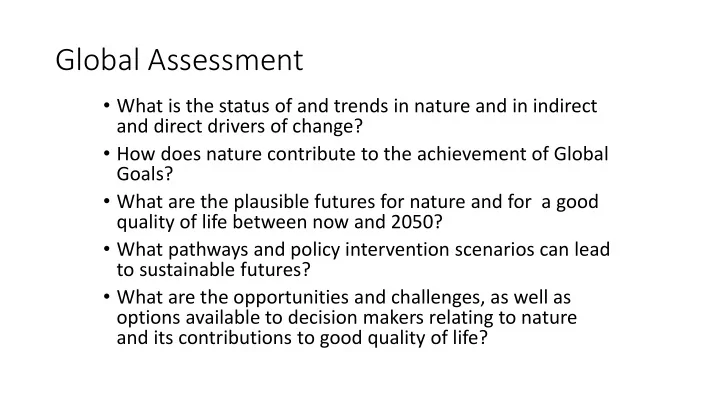

Global Assessment • What is the status of and trends in nature and in indirect and direct drivers of change? • How does nature contribute to the achievement of Global Goals? • What are the plausible futures for nature and for a good quality of life between now and 2050? • What pathways and policy intervention scenarios can lead to sustainable futures? • What are the opportunities and challenges, as well as options available to decision makers relating to nature and its contributions to good quality of life?
The Author Team 9% 145 experts: 33% Social interdisciplinary Scientists Scientists 3 co-chairs 24 coordinating lead authors 87 lead authors 15 review editors 58% Natural Scientists 16 fellows 350 contributing authors 37.2% Women From 51 countries ~156,000 Hours of Voluntary 62.8% Men Hours = ~17 years
Life on Earth is deteriorating fast worldwide. Virtually all indicators of the global state of nature are decreasing: biomes, ecosystems, species, varieties and breeds
More species of plants and animals are threanted with extinction now than at any other time in human history
More species of plants and animals are threated with extinction now than at any other time in human history
Underpinning the proximate causes of deterioration in nature are the root causes, or indirect drivers of change. S DIRECT DRIVERS O C Terrestrial I A L Freshwater V Marine A L U E S
Most of the assessed categories of nature‘s vital contributions to people are declining globally since the 1970s Only the production of food, energy and raw materials has increased
The potential for nature to sustainably contribute to human quality of life has declined for almost all contributions analysed
Aichi Biodiversity Targets Sustainable Development Goals
Progress towards the Aichi Biodiversity Targets [SIMPLIFIED AICHI TABLE]
Progress towards the UN Sustainable Development Goals [SIMPLIFIED SDG TABLE]
Plausible futures SCENARIOS Economic optimism - rapid economic growth - low regulation Regional competition - strong trade and other barriers - growing gap between rich and poor Global sustainability - Proactive environmental policy - Sustainable production and consumption
Projected changes in biodiversity and nature’s material and regulating benefits, due to climate & land use change by 2050
Projected changes in biodiversity and nature’s material and regulating benefits, due to climate & land use change by 2050
Other plausible scenarios, which include transformative change, are compatible with the 2030 sustainability objectives and the 2050 Vision for Biodiversity. Photocredit Daniel M. Cáceres
Contributions of Indigenous Peoples and Local Communities: knowledge, innovations, practices, and institutions ➢ 25% global land ➢ 35% highly conserved ecosystems and 35% of Protected Areas ➢ Agrobiodiversity ➢ Nature is declining less rapidly (450+ indicators used by local communities) ➢ Yet, 72% of local indicators show decline ➢ Increasingly under pressure
We have dramatically reconfigured the fabric of life of the planet. The world is becoming much more interconnected, yet increasingly unequal.
Confronting the challenge of f meeting international societal and environmental goals for the next xt decades Key components for transformation
Challenges related to climate change, nature deterioration and achieving a good quality of life for all are interconnected. And, they need to be addressed synergistically, from local to global levels. Food , water , energy , health , human well-being for all, mitigating and adapting to climate change , and conserving nature can be achieved together in sustainable pathways.
Need for rapid implementation of existing instruments and bold decisions for transformative change. Knowledge and tools available … implementation!
Meeting global societal goals through urgent and concerted efforts addressing the direct drivers and especially the root causes (indirect drivers) of nature deterioration. Align governance systems, both in the public sector Governance (across admin levels for instance) but also across sectors Responsability, whole chain from production to Economic systems consumption Inequalities are real, incoporate them actively in the Equity planning and implementation We kave better knowledge and tools Cross-sectoral planning Eliminate harmful subsidies, incentive positive Incentives externalities Individual level: wasteful consumption does not equal Narratives quality of life or status Environmental degradatiom, social inequalities are not Societal values inevitable outcomes of economic growth
Subset of solutions
Cross-Sectoral, Integrated Management at Multiple Levels → Food production and conservation goals: complementary and interdependent. → Sustainable fisheries: integrated management on land, in freshwater and oceans → Land-based climate change mitigation: attention to trade-offs → Nature-based solutions in cities: crucial for global sustainability
Recognizing the knowledge, innovations and practices, institutions and values of indigenous peoples and local communities and their inclusion and participation in environmental governance. E nhances their quality of life, as well as nature conservation and sustainable use, relevant to broader society.
A key constituent of sustainable pathways is the evolution of global financial and economic systems to build a global sustainable economy. One that steers away from the current limited paradigm of economic growth.
Many societal responses and successful examples, rapid transformative change is already happening in many sectors. Bold actions and commitment from local to global levels urgently needed.
Recommend
More recommend